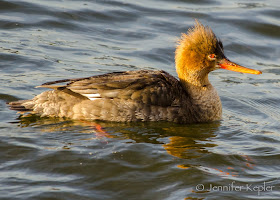I look forward to ANY good reason to bird. This span of 4 days (2/15-2/18) is the Great Backyard Bird Count an amazing community scientist initiative to get folks out looking at, counting, and identifying birds. Whether this is your first time or millionth, it's for everyone!
There are some great birds out there for all to see and I got to share a well-showing life bird with my dad, yesterday afternoon as I birded some area of Long Island, with all target species I was looking to see squired. That is also a very nice feeling! And sharing birding with someone is always extra special.
 |
| I began at Point Lookout, not much variety in the water. But the long-tailed ducks, few common eiders, and brant were riding the waves, practically with their eyes closed. |
 |
| A handsome male shows off his namesake long tail, blowing in the wind. |
 |
| Sanderlings ran after and ran from the waves. The morning was very cloudy and mono-tone in color. |
 |
Next I went to Jones Beach, stopped at the coast guard station and then the parking lots, mainly looking for horned lark and snow bunting (above).
Was happy to have found both! |
 |
| Snow bunting are very cute in their winter plumes, little rust colored cheeks, their overall coloration blends them super well into the dunes. As opposed to their stark black and white breeding plumage, giving them the "snow" in their name -- besides the fact they are a bird of the high north. |
 |
After making a grilled cheese at my parents house and enjoying the finer things I never have in my home, like Pringles, cookies, and an Entemann's donut... And "putting together" my dad's binoculars (attaching the strap). I magically convinced my dad to come find another target bird with me, a Pacific Loon.
And as described by others, it was exactly where it has been for the last week plus!
My dad wondered, as most do- if this loon is not from here, why is it here? Well, these birds breed in the Arctic and winter, normally along the west coast on the ocean, bays, and estuaries out there. But when you have wings a page in a book does not determine where you should be. Yes, birds often go to and return to the same place but sometimes you take a wrong turn, get blown off course, or even find good resources elsewhere. The Cornell Lab of Ornithology on their range map page for birds now includes a sightings map, compiled from ebird data, showing reported sightings - and its pretty interesting to see how the two maps differ. You just never know when a bird will show up and break the rules of its range! |
 |
A life bird for both my dad and I!
Birding helps create memories and I'm glad I got to share this moment with my dad. |
 |
So, what makes them different from the common and red throated loons we often see in winter at our coast?
Well for one, that chinstrap. Although it isn't always easy to see or visible. It is much so on this bird.
Also, the bill is thinner, less heavy than a common loon - and common loon tends to me at least to look a bit heavier bodied than this bird. It's back is also very dark, compared to the loons we usually see here. |
 |
| Another field mark I like in particular, but not unique to this species - is that striping that fades into their chest. I never really see that well defined on the winter plumage of common loons, but you will see it the breeding plumage of most loon species. |
 |
We enjoyed watching this bird at close range from the walkway above the marina in Oyster Bay. It darted under docks, between boats and seemed to know when all the shell fishermen would come in for the day, in mid afternoon where it would change its location to just outside the marina to avoid the small boat traffic.
I love sharing birding with others and glad to have my dad along for this one!
...Now, onto day 2 with owls, harriers, and pasta! |



















































